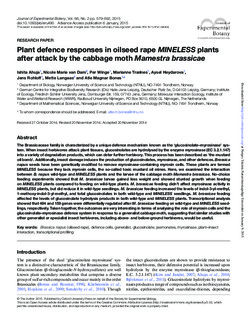| dc.contributor.author | Ahuja, Ishita | |
| dc.contributor.author | van Dam, Nicole | |
| dc.contributor.author | Winge, Per | |
| dc.contributor.author | Trælnes, Marianne | |
| dc.contributor.author | Heydorova, Aysel | |
| dc.contributor.author | Rohloff, Jens | |
| dc.contributor.author | Langaas, Mette | |
| dc.contributor.author | Bones, Atle M. | |
| dc.date.accessioned | 2017-11-07T13:44:52Z | |
| dc.date.available | 2017-11-07T13:44:52Z | |
| dc.date.created | 2014-12-05T17:21:30Z | |
| dc.date.issued | 2015 | |
| dc.identifier.citation | Journal of Experimental Botany. 2015, 66 (2), 579-592. | nb_NO |
| dc.identifier.issn | 0022-0957 | |
| dc.identifier.uri | http://hdl.handle.net/11250/2464695 | |
| dc.description.abstract | The Brassicaceae family is characterized by a unique defence mechanism known as the ‘glucosinolate–myrosinase’ system. When insect herbivores attack plant tissues, glucosinolates are hydrolysed by the enzyme myrosinase (EC 3.2.1.147) into a variety of degradation products, which can deter further herbivory. This process has been described as ‘the mustard oil bomb’. Additionally, insect damage induces the production of glucosinolates, myrosinase, and other defences. Brassica napus seeds have been genetically modified to remove myrosinase-containing myrosin cells. These plants are termed MINELESS because they lack myrosin cells, the so-called toxic mustard oil mines. Here, we examined the interaction between B. napus wild-type and MINELESS plants and the larvae of the cabbage moth Mamestra brassicae. No-choice feeding experiments showed that M. brassicae larvae gained less weight and showed stunted growth when feeding on MINELESS plants compared to feeding on wild-type plants. M. brassicae feeding didn’t affect myrosinase activity in MINELESS plants, but did reduce it in wild-type seedlings. M. brassicae feeding increased the levels of indol-3-yl-methyl, 1-methoxy-indol-3-yl-methyl, and total glucosinolates in both wild-type and MINELESS seedlings. M. brassicae feeding affected the levels of glucosinolate hydrolysis products in both wild-type and MINELESS plants. Transcriptional analysis showed that 494 and 159 genes were differentially regulated after M. brassicae feeding on wild-type and MINELESS seedlings, respectively. Taken together, the outcomes are very interesting in terms of analysing the role of myrosin cells and the glucosinolate–myrosinase defence system in response to a generalist cabbage moth, suggesting that similar studies with other generalist or specialist insect herbivores, including above- and below-ground herbivores, would be useful. | nb_NO |
| dc.language.iso | eng | nb_NO |
| dc.publisher | Oxford University Press (OUP) for Society for Experimental Biology | nb_NO |
| dc.rights | Navngivelse 4.0 Internasjonal | * |
| dc.rights.uri | http://creativecommons.org/licenses/by/4.0/deed.no | * |
| dc.title | Plant defence responses in oilseed rape MINELESS plants after attack by the cabbage moth Mamestra brassicae | nb_NO |
| dc.type | Journal article | nb_NO |
| dc.type | Peer reviewed | nb_NO |
| dc.description.version | publishedVersion | nb_NO |
| dc.source.pagenumber | 579-592 | nb_NO |
| dc.source.volume | 66 | nb_NO |
| dc.source.journal | Journal of Experimental Botany | nb_NO |
| dc.source.issue | 2 | nb_NO |
| dc.identifier.doi | 10.1093/jxb/eru490 | |
| dc.identifier.cristin | 1181547 | |
| dc.relation.project | Norges forskningsråd: 214329 | nb_NO |
| dc.description.localcode | © The Author 2015. Published by Oxford University Press on behalf of the Society for Experimental Biology. This is an Open Access article distributed under the terms of the Creative Commons Attribution License (http://creativecommons.org/licenses/by/3.0/), which permits unrestricted reuse, distribution, and reproduction in any medium, provided the original work is properly cited. | nb_NO |
| cristin.unitcode | 194,66,10,0 | |
| cristin.unitcode | 194,63,15,0 | |
| cristin.unitname | Institutt for biologi | |
| cristin.unitname | Institutt for matematiske fag | |
| cristin.ispublished | true | |
| cristin.fulltext | original | |
| cristin.qualitycode | 2 | |

